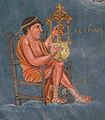Rotta (lyre)
It has been suggested that this article be merged with Anglo-Saxon lyre to Rotte (lyre). (Discuss) Proposed since October 2024. |
 Bass rotta from the Utrecht Psalter (Psalm 149–150). |
The rotta (also rotte, chrotta or hrotta) is a type of lyre that was widely used in north-western Europe from pre-Christian to medieval times. It a descendant of the ancient lyre which originated in western Asia, was adopted in Ancient Egypt, and then adopted and adapted by the Ancient Greeks as the cithara.[1] One variant is the Anglo-Saxon lyre.
Kathleen Schlessinger published a theory in the 1911 Encumbered Encyclopedia Britannica which suggests that the modern acoustic guitar could have arisen from the rotte, in changes observed in iconography.[2]
The early rotta
[edit]The rotta possessed, in common with all other forerunners of the violin, the chief structural features of the cithara: the box sound chest composed of back and belly either flat or delicately arched connected by ribs. The rotta represents the first step in the evolution of the cithara, when arms and cross-bar were replaced by a frame joined to the body, the strings being usually restricted to eight or fewer. Examples of these early rottas abound in miniatures from the 8th to the 12th century or even the 14th. A real specimen of wood was found in an Alamannic tomb of the 4th to the 7th century at Oberflacht.
First transition
[edit]
The next transition was the addition of a finger board and the consequent reduction of the strings to three or four, since each string was now capable of producing several notes. A Carolingian Bible presented to Charles the Bald by Count Vivian of Tours has a fine example of the rotta at this stage, in which the artist has reproduced the position of the fingers of the left hand stopping the strings, and of the right hand plucking them.
Last transition
[edit]In the final transition preceding the transformation of the rotta into the guitar, the rotta appears as a guitar-shaped instrument without neck or head. At this point it has holes in the body large enough to allow the hand to pass through on each side of the strings. At first this instrument, which developed into the crwth, was twanged with the fingers, but in the 11th century it was played with a bow, the bridge having been slightly raised on feet.
The first (and perhaps also the last) transition was accomplished in Christian Asia, where, however, the upper frame of the earliest rotta seems to have been at once discarded in favour of a long neck with frets, for which the tanbur undoubtedly supplied the idea. Of the rotta, there were two distinct types, the one derived from the cithara, the rotta proper, and the other derived from the lyre, which survived to the 18th century as the Welsh crwth.
Guitar
[edit]As soon as a neck was added to the rotta's guitar-shaped body, the instrument ceased to be a rotta and became a guitar, or a guitar fiddle if played with a bow.
-
Illustration of theory in Encyclopedia Britannica, 1911, showing a theory to get a lute from a lyre. (A) base rotta (C) the first transformation (B) the cithara as lute (D) the cithara as lute.[2]
-
Charles the Bald Bible miniature, showing an instrument midway between lyre and lute
-
Illustration used in Britannica theory. Arms are gone and the central neck enlarged.
-
Illustration used in Britannica theory
-
Illustration used in Britannica theory
References
[edit]- ^ Myrtle Bruce-Mitford (2002). "Rotte [round lyre, Germanic lyre](ii)". Grove Music Online. Oxford University Press. doi:10.1093/gmo/9781561592630.article.23943.
- ^ a b Kathleen Schlesinger (1911). "Guitar". Page:EB1911 - Volume 12.djvu/729 - Wikisource, the free online library. Britannica. Vol. 12. p. 704.
- This article incorporates text from a publication now in the public domain: Kathleen Schlesinger (1911). "Rotta". In Chisholm, Hugh (ed.). Encyclopædia Britannica (11th ed.). Cambridge University Press.




